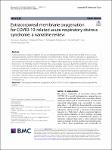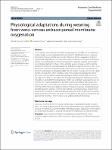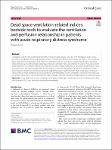Search
Author
- Chi, Xu (1)
- Florian, Reizine (1)
- Francesco, Alessandri (1)
- Jean-Pierre, Gangneux (1)
- next >
Subject
- Antifungal management ... (1)
- Cumulative evidence (1)
- extracorporeal membran... (1)
- Veno-venous extracorpo... (1)
- next >
Date issued
- 2023 (5)
Has File(s)
- true (5)
Search Results
The risk of death in sepsis patients with acute respiratory distress syndrome (ARDS) was as high as 20–50%. Few studies focused on the risk identification of ARDS among sepsis patients. This study aimed to develop and validate a nomogram to predict the ARDS risk in sepsis patients based on the Medical Information Mart for Intensive Care IV database. |
A growing body of evidence supports the use of extracorporeal membrane oxygenation (ECMO) for severe acute respiratory distress syndrome (ARDS) refractory to maximal medical therapy. ARDS may develop in a proportion of patients hospitalized for coronavirus disease 2019 (COVID-19) and ECMO may be used to manage patients refractory to maximal medical therapy to mitigate the risk of ventilator-induced lung injury and provide lung rest while awaiting recovery. The mortality of COVID-19-related ARDS was variously reassessed during the pandemic. |
Over the last 5 years, viral induced acute respiratory distress syndrome (ARDS) has emerged as a major risk factor for invasive fungal infections in ICU patients worldwide [1, 2]. Pulmonary aspergillosis, being reported in 15–27% of critical COVID-19 patients [2, 3] and in nearly 20% of Influenza associated ARDS patients [1], appears to be the main fungal infection involved. |
Veno-venous extracorporeal membrane oxygenation (V–V ECMO) has an established evidence base in acute respiratory distress syndrome (ARDS) and has seen exponential growth in its use over the past decades. However, there is a paucity of evidence regarding the approach to weaning, with variation of practice and outcomes between centres. Preconditions for weaning, management of patients’ sedation and mechanical ventilation during this phase, criteria defining success or failure, and the optimal duration of a trial prior to decannulation are all debated subjects. Moreover, there is no prospective evidence demonstrating the superiority of weaning the sweep gas flow (SGF), the extracorporeal blood flow (ECBF) or the fraction of oxygen of the SGF (FdO2), thereby a broad inter-centre variabi... |
Cumulative evidence has demonstrated that the ventilatory ratio closely correlates with mortality in acute respiratory distress syndrome (ARDS), and a primary feature in coronavirus disease 2019 (COVID-19)-ARDS is increased dead space that has been reported recently. Thus, new attention has been given to this group of dead space ventilation-related indices, such as physiological dead space fraction, ventilatory ratio, and end-tidal-to-arterial PCO2 ratio, which, albeit distinctive, are all global indices with which to assess the relationship between ventilation and perfusion. |




